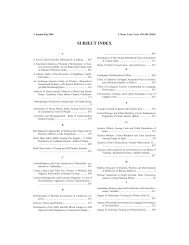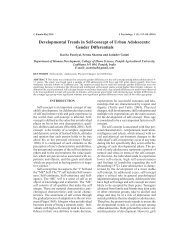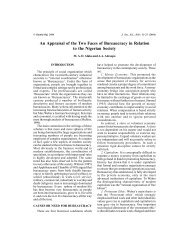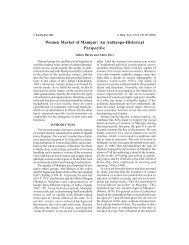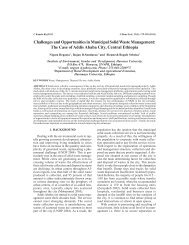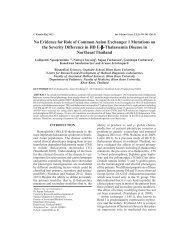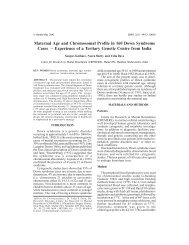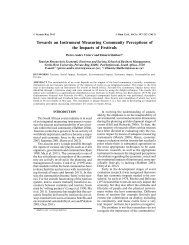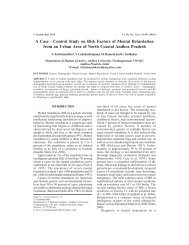Health Coverage in Mass Media - Kamla-Raj Enterprises
Health Coverage in Mass Media - Kamla-Raj Enterprises
Health Coverage in Mass Media - Kamla-Raj Enterprises
Create successful ePaper yourself
Turn your PDF publications into a flip-book with our unique Google optimized e-Paper software.
© <strong>Kamla</strong>-<strong>Raj</strong> 2010 J Communication, 1(1): 19-25 (2010)<br />
<strong>Health</strong> <strong>Coverage</strong> <strong>in</strong> <strong>Mass</strong> <strong>Media</strong>: A Content Analysis<br />
Achala Gupta and A. K. S<strong>in</strong>ha<br />
Department of Anthropology, Panjab University, Chandigarh 160 014, India<br />
Telephone: 0091- 0172-2534226, Mobile: 0091- 9417770566;<br />
E-mail: achalagupta8@gmail.com<br />
KEYWORDS <strong>Health</strong> Articles. Messages. Advertisements. <strong>Health</strong> Products<br />
ABSTRACT There is a greater demand and need for accurate, relevant, rapid and impartial public health <strong>in</strong>formation by<br />
people, and a grow<strong>in</strong>g reliance on mass media as the ma<strong>in</strong> source of <strong>in</strong>formation. It is well known that the mass media are<br />
an important social <strong>in</strong>stitution <strong>in</strong> any modern society. The study was conducted on the health related messages that appear<br />
<strong>in</strong> pr<strong>in</strong>t media (Newspaper and Magaz<strong>in</strong>e) and electronic media (Television and Radio). The radio and television channels,<br />
newspapers and magaz<strong>in</strong>e used for the analysis were randomly chosen. This aspect of the study gave the researchers an<br />
<strong>in</strong>sight <strong>in</strong>to <strong>in</strong>volvement of the media with<strong>in</strong> the health communications. Detailed content analysis of various communication<br />
media concluded that all types of media provide <strong>in</strong>formation regard<strong>in</strong>g health matters but political, social, crime and<br />
sports news were primarily covered <strong>in</strong> both pr<strong>in</strong>t and electronic media.<br />
INTRODUCTION<br />
<strong>Mass</strong> media provide <strong>in</strong>formation among<br />
people at large so that there is acceptance of any<br />
idea to create <strong>in</strong>terest. <strong>Mass</strong> media displays <strong>in</strong>formation<br />
about health and make people aware<br />
so as to prevent the spread of various diseases.<br />
There are various types of mass media (magaz<strong>in</strong>es,<br />
television, <strong>in</strong>ternet, newspapers, etc.). The<br />
media have the power to direct our attention<br />
towards certa<strong>in</strong> issues. This is the agenda sett<strong>in</strong>g<br />
theory. In the words of Cohen (1963), the media<br />
“may not be successful <strong>in</strong> tell<strong>in</strong>g their readers<br />
what to th<strong>in</strong>k, but are stunn<strong>in</strong>gly successful <strong>in</strong><br />
tell<strong>in</strong>g their readers what to th<strong>in</strong>k about”. Freimuth<br />
et al. (1984) have shown that many people rely on<br />
the news media for their health-related <strong>in</strong>formation.<br />
Policy makers also obta<strong>in</strong> considerable<br />
amount of <strong>in</strong>formation from the media. As Bryant<br />
and Thompson (2002) have suggested that news<br />
coverage of health matters takes on considerable<br />
significance, that has the potential to shape the<br />
impression of average citizens and powerful<br />
policy makers alike. In the words of Brown and<br />
Walsh-Childers (1994), news coverage of health<br />
“tends to ascribe the power to control <strong>in</strong>dividuals’<br />
health to medical experts us<strong>in</strong>g high-technology<br />
equipment”. Studies have also shown that the<br />
news media tend to <strong>in</strong>crease their coverage of<br />
health concerns as they affect the society’s ma<strong>in</strong>stream<br />
and/or the greatest number of people <strong>in</strong><br />
their audience.<br />
The purpose of the content analysis is to study<br />
systematically health related messages <strong>in</strong> different<br />
communication media. The communication<br />
media can be divided <strong>in</strong>to electronic and pr<strong>in</strong>t<br />
media. The electronic media such as television<br />
and radio, and pr<strong>in</strong>t media such as newspaper and<br />
magaz<strong>in</strong>e were used <strong>in</strong> this study. The communication<br />
media are dom<strong>in</strong>ant feature of our day to<br />
day life and available both <strong>in</strong> domestic and public<br />
environments. They <strong>in</strong>tend to engage people, to<br />
convey some k<strong>in</strong>d of <strong>in</strong>formation, and to produce<br />
reactions <strong>in</strong> their audiences which justify their<br />
cont<strong>in</strong>u<strong>in</strong>g production. Sometimes the ma<strong>in</strong> message<br />
is clear to the audience but it is also likely<br />
that some other mean<strong>in</strong>g is produced <strong>in</strong> audience<br />
m<strong>in</strong>d unconsciously. The purpose of these messages<br />
is to engage an audience and <strong>in</strong>fluence his/<br />
her way of th<strong>in</strong>k<strong>in</strong>g about certa<strong>in</strong> subject.<br />
Content analysis method is used for qualitative<br />
and quantitative analysis of health related<br />
topics covered <strong>in</strong> several communication media.<br />
Stacks and Hock<strong>in</strong>g (1992) def<strong>in</strong>ed content analysis<br />
as “a research method or a measurement<br />
technique that <strong>in</strong>volves the systematic study of<br />
the content of communication messages”. Holsti<br />
(1969) gave some steps <strong>in</strong> carry<strong>in</strong>g out content<br />
analysis research such as select<strong>in</strong>g and def<strong>in</strong><strong>in</strong>g<br />
content categories; def<strong>in</strong><strong>in</strong>g the unit of analysis;<br />
decid<strong>in</strong>g on a system of enumeration; and carry<strong>in</strong>g<br />
out analysis. Hartmann and Husband (1974)<br />
op<strong>in</strong>ed “despite its limitations, content analysis<br />
enables us to say “someth<strong>in</strong>g about what is be<strong>in</strong>g<br />
called ‘event as news’ — that is, the version of the<br />
world daily laid before the public as a k<strong>in</strong>d of<br />
suggested agenda for their thought, discussion<br />
and action”.<br />
A health content analysis is a useful tool to<br />
know how media delivers health messages and
20 ACHALA GUPTA AND A. K. SINHA<br />
the way <strong>in</strong> which population receives this health<br />
<strong>in</strong>formation <strong>in</strong> terms of the amount of space<br />
related to health issues and formats of this space<br />
as articles, editorials, letters, advertisements, visual<br />
references, graphics, etc. (Roberts 2004).<br />
Several researchers had used content analysis to<br />
study health related research areas. Bonnie and<br />
George (1975) discussed the role of radio and<br />
television on the announcements for family plann<strong>in</strong>g.<br />
Dubey and Burdhan (1981) developed a<br />
module on content analysis of message and<br />
programmes <strong>in</strong> health and population communication,<br />
to orient and develop a greater appreciation<br />
and understand<strong>in</strong>g of communication research<br />
among middle and lower level field workers.<br />
S<strong>in</strong>gh Archna (2007) studied the role of mass<br />
communication <strong>in</strong> prevention and control of AIDS<br />
us<strong>in</strong>g content analysis of Indian newspapers.<br />
Content analysis has been applied to written<br />
documents with varied and complex content,<br />
<strong>in</strong>clud<strong>in</strong>g newspaper editorials (Namenwirth<br />
1968), political party platforms (Weber 1990),<br />
novels (Griswold 1981) and recorded speeches<br />
(Seider 1974).<br />
There is a greater demand and need for accurate,<br />
relevant, rapid and impartial public health<br />
<strong>in</strong>formation by people, and a grow<strong>in</strong>g reliance on<br />
mass media as the ma<strong>in</strong> source of <strong>in</strong>formation.<br />
The public health community usually looks to the<br />
media for support, attention and endorsement<br />
and are considered as a primary source of health<br />
and science <strong>in</strong>formation, even for health professionals.<br />
On the other hand, they are also seen as<br />
an important tool to dissem<strong>in</strong>ate health <strong>in</strong>formation<br />
to the population. The news media are quite<br />
important <strong>in</strong> furnish<strong>in</strong>g the public with health<br />
<strong>in</strong>formation. In l<strong>in</strong>e with the agenda-sett<strong>in</strong>g theory,<br />
Bryant and Thompson (2002) are of the view that<br />
“news coverage of health matters takes on considerable<br />
significance, <strong>in</strong> that it has the potential<br />
to shape the impressions of average citizens and<br />
powerful policy makers alike”.<br />
METHOD<br />
Content analysis was conducted on the health<br />
related messages that appear <strong>in</strong> the pr<strong>in</strong>t and<br />
electronic media. Tak<strong>in</strong>g a sample of 2 newspapers,<br />
the messages appear<strong>in</strong>g <strong>in</strong> them were studied<br />
dur<strong>in</strong>g the year 2008. Similarly, a study of<br />
electronic media was conducted through observation<br />
method. The health messages broadcast or<br />
telecast by the electronic media dur<strong>in</strong>g the same<br />
time period have been observed. The radio and<br />
television channels, newspapers and magaz<strong>in</strong>e<br />
used for the analysis were randomly chosen. This<br />
aspect of the study gave the researchers an <strong>in</strong>sight<br />
<strong>in</strong>to <strong>in</strong>volvement of the media with<strong>in</strong> the health<br />
communications.<br />
Radio<br />
RESULTS AND DISCUSSION<br />
<strong>Health</strong> messages can be delivered by radio <strong>in</strong><br />
many different forms. News items about health<br />
events can form a part of regular news broadcasts.<br />
Special education programmes on health<br />
topics can be broadcast, rang<strong>in</strong>g <strong>in</strong> length from a<br />
few m<strong>in</strong>utes to an hour or more. These can be <strong>in</strong><br />
the form of talks, <strong>in</strong>terviews, or discussion<br />
programmes at the radio station.<br />
In Chandigarh, there are three radio stations<br />
namely Big FM (92.7 MHz) which is owned by<br />
Anil Dhirubhai Ambani, Bhaskar (H<strong>in</strong>di) newspaper<br />
group owned My FM operat<strong>in</strong>g at 94.3<br />
MHz and Prasar Bharti owned by the Government<br />
(103.1 MHz). Out of these three, the researchers<br />
chose Big FM (92.7 MHz) randomly<br />
and heard the broadcast for one week cont<strong>in</strong>uously.<br />
It was found that on an average there were<br />
40-50 health related items be<strong>in</strong>g broadcast per<br />
day. Out of these, approximately 20-25 advertisements<br />
were of some health cl<strong>in</strong>ics or hospitals,<br />
etc.; 7-10 were related to cosmetic and<br />
herbal products; and 9-13 were general medic<strong>in</strong>es<br />
advertisements (Vicco-cream, Dettol,<br />
Gelusil, etc.). There were approximately 7-9<br />
health related messages related to different issues<br />
like hygiene, mother-child health care and<br />
immunisation of children. It was also found that<br />
one day before the polio-day (Sunday) the message<br />
regard<strong>in</strong>g immunisation was played several<br />
times. The message was announced normally for<br />
10 to 15 seconds.<br />
The researchers also listened a health related<br />
phone-<strong>in</strong> program for eight months that is, from<br />
September, 2007 to April, 2008. The programme<br />
named FM Lifel<strong>in</strong>e was aired every Tuesday<br />
from 11.00 to 11.30 am on Prasar Bharti (103.1<br />
MHz). The programme was hosted by Sarvpriya<br />
Nirmohi and it was a phone-<strong>in</strong> programme <strong>in</strong><br />
which a doctor was called and he/she gave advice<br />
and solved health related queries of people who<br />
called for help. The different issues dealt were<br />
normally related to AIDS, immunisation of chil-
HEALTH COVERAGE IN MASS MEDIA 21<br />
dren, different types of cancer, oral health, <strong>in</strong>fections<br />
(viral, bacterial and fungal), eyes, <strong>in</strong>juries,<br />
respiratory problems, gynecological problems,<br />
jo<strong>in</strong>t pa<strong>in</strong>s, neurological problems, lifestyle diseases<br />
(diabetes, hypertension), cardiac problems,<br />
different types of allergies, and aches, etc. On an<br />
average, 5 to 10 callers from various places<br />
called seek<strong>in</strong>g help. The programme was sponsored<br />
by Dishu Sarees, Ambala City, Chann di<br />
Hatti, Ambala City, and Director of <strong>Health</strong> Services,<br />
Punjab. Sometimes there was an advertisement<br />
of some cl<strong>in</strong>ic or hospital and messages on<br />
female foeticide, mother child health, and<br />
immunisation of children before and after the<br />
programme. While listen<strong>in</strong>g to the programme<br />
the researchers found that some of the callers<br />
used to thank Prasar-Bharti for air<strong>in</strong>g such an<br />
important and <strong>in</strong>formative health-related<br />
programme. Thus, spread<strong>in</strong>g knowledge and creat<strong>in</strong>g<br />
awareness among people may prove fruitful<br />
for the general public and help them <strong>in</strong> ma<strong>in</strong>ta<strong>in</strong><strong>in</strong>g<br />
their health.<br />
The researchers also <strong>in</strong>terviewed two of the<br />
sponsors. First was Dishu Sarees, Ambala City.<br />
The owner said that they chose this programme<br />
for sponsor<strong>in</strong>g because this was very <strong>in</strong>formative<br />
and awareness creat<strong>in</strong>g programme for the ma<strong>in</strong>tenance<br />
of health. He also told that some of their<br />
customers told them that they have listened to<br />
their advertisement before the programme. The<br />
other one Sirh<strong>in</strong>d Bawasir Hospital, Sirh<strong>in</strong>d was<br />
<strong>in</strong>terviewed by phone only. The owner said that<br />
he chose this particular programme for sponsor<strong>in</strong>g<br />
because he thought that people would like to<br />
listen to this programme as it was really a very<br />
educat<strong>in</strong>g and <strong>in</strong>formative programme which<br />
could help people to ma<strong>in</strong>ta<strong>in</strong> their health and<br />
prevent them from various life threaten<strong>in</strong>g diseases.<br />
Television<br />
Television can have a great impact on people.<br />
It can extend knowledge, <strong>in</strong>fluence public op<strong>in</strong>ion,<br />
and <strong>in</strong>troduce new ways of life. In the health<br />
field, <strong>in</strong> urban areas and <strong>in</strong> rural communities, it<br />
has already served as a powerful advocate of<br />
healthy behaviour. The researchers chose one<br />
enterta<strong>in</strong>ment channel, one spiritual and one news<br />
channel randomly to watch on TV. The researchers<br />
watched these channels for one week each<br />
from 8.00 am to 11.00 pm. The enterta<strong>in</strong>ment<br />
channel chosen was Colors channel. It was found<br />
that on an average there were 7-9 health messages<br />
per day which were related to jo<strong>in</strong>t replacement,<br />
pneumonia vacc<strong>in</strong>ation, and mother-child<br />
health care. There was preponderance of advertisements<br />
as there were approximately 30-35<br />
advertisements of beauty products; 20-22 were<br />
related to female utility items; 10-12 were on<br />
health or energy dr<strong>in</strong>ks (Boost and Horlicks,<br />
etc.); 10-12 were general medic<strong>in</strong>es advertisements<br />
(Croc<strong>in</strong>, Moov, Cough-Syrup, etc.); 11-13<br />
were on oral health (tooth brush and tooth paste<br />
related); 2-5 were related to various contraceptives;<br />
around 5-6 were on cook<strong>in</strong>g oils; approximately<br />
5-7 were related to ayurvedic products<br />
like Chawanprash, and Dabur products; and 10-<br />
12 were related to baby products (nappies, baby<br />
food, etc.).<br />
It is generally found that the spiritual channel<br />
is ma<strong>in</strong>ly listened to by aged people. The channel<br />
chosen was Divya. It was found that very few<br />
advertisements and messages were there on this<br />
particular channel. If there was some advertisement,<br />
it was ma<strong>in</strong>ly related to some herbal or<br />
ayurvedic product. Everyday there was a phone<strong>in</strong>-programme<br />
<strong>in</strong> which an astrologer was called<br />
to answer the health related problems of people.<br />
The astrologer correlated the problems with their<br />
sunsh<strong>in</strong>e and stars and thus told them remedies<br />
accord<strong>in</strong>gly. There was a program Dadi-Maa <strong>in</strong><br />
which an old lady gave home remedies. This<br />
program was repeated 6 to 8 times <strong>in</strong> a day.<br />
The news channel that was chosen was IBN7.<br />
It is a H<strong>in</strong>di news channel. Comparatively, there<br />
were more health messages. On an average, there<br />
were 9-14 health messages <strong>in</strong> a day. The messages<br />
were ma<strong>in</strong>ly on mother-child health, flu,<br />
knee replacement, dengue and chickengunia and<br />
on oral health. There was a phone-<strong>in</strong> health<br />
programme everyday from 2.00 to 2.30 pm. In<br />
this the doctor adviced and solved the health<br />
related queries of people who called <strong>in</strong> for help.<br />
The health related advertisements numbered 35-<br />
40. Out of these, 5-7 were on contraceptives; 4-<br />
6 were related to baby products; 14-16 were<br />
cosmetic related products and 10-12 were on<br />
general medic<strong>in</strong>es (fast relief balm, cough syrup,<br />
Croc<strong>in</strong>, Gelusil,etc.).<br />
Newspaper<br />
The ma<strong>in</strong> purpose of newspapers is to spread<br />
<strong>in</strong>formation. They pr<strong>in</strong>t ‘news’, which usually<br />
consists of reports of events. They also <strong>in</strong>clude
22 ACHALA GUPTA AND A. K. SINHA<br />
‘features’, which are articles on a particular topic,<br />
and ‘editorials’, which express op<strong>in</strong>ions about<br />
various subjects. <strong>Health</strong> topics can fit <strong>in</strong>to any of<br />
these categories. <strong>Health</strong> news might be a report<br />
of the launch<strong>in</strong>g of an immunisation campaign,<br />
or a speech about health made by a well-known<br />
official. A health feature might be an article by a<br />
doctor about a certa<strong>in</strong> disease or health practice.<br />
A health editorial might urge people to take part<br />
<strong>in</strong> a clean water programme. Newspapers reach<br />
many people, very quickly. The press can play a<br />
very important part <strong>in</strong> <strong>in</strong>creas<strong>in</strong>g people’s knowledge<br />
about health. Accord<strong>in</strong>g to Brown and<br />
Walsh-Childers (1994), news coverage “tends to<br />
ascribe the power to control <strong>in</strong>dividual’s health<br />
to medical experts us<strong>in</strong>g high-technology”.<br />
The newspaper distributor of the study area<br />
(Kuldeep News Agency and Magaz<strong>in</strong>e Suppliers,<br />
Shop No. 2228, Pipliwala Town, Manimajra,<br />
Chandigarh) told the researchers that his family<br />
had been distribut<strong>in</strong>g the newspaper <strong>in</strong> the area<br />
for the last 60 years. His father started distribut<strong>in</strong>g<br />
the newspaper <strong>in</strong> the area and he used to<br />
distribute approximately 200 copies a day. In the<br />
span of 60 years, the number of newspaper copies<br />
to be distributed <strong>in</strong>creased 10 times and thus the<br />
number reached up to 2000 copies a day. Further,<br />
he told that <strong>in</strong> Manimajra and nearby areas like<br />
Kishangarh, Daria, Mansa Devi Complex, Modern<br />
Hous<strong>in</strong>g Complex, etc. a total of 18 newspaper<br />
distributors were distribut<strong>in</strong>g the newspapers<br />
and magaz<strong>in</strong>es and they all got the newspapers<br />
from Ramkishan News Distributor, situated <strong>in</strong><br />
Panchkula. The number of copies of newspapers<br />
distributed <strong>in</strong> the area <strong>in</strong> a day is given <strong>in</strong> Figure<br />
1.<br />
The researchers selected one H<strong>in</strong>di and one<br />
English language newspaper for content analysis.<br />
The newspapers were chosen on the basis of<br />
highest readership <strong>in</strong> the area. Thus, Da<strong>in</strong>ik<br />
Bhaskar (H<strong>in</strong>di) and The Tribune (English) were<br />
chosen for the whole one year of 2008 for the<br />
Number of copies<br />
800<br />
700<br />
600<br />
500<br />
400<br />
300<br />
200<br />
100<br />
0<br />
Da<strong>in</strong>ik Bhaskar<br />
Amar Ujala<br />
The Tribune<br />
H<strong>in</strong>dustan Times<br />
Punjab Kesari<br />
Times of India<br />
Punjabi Tribune<br />
Da<strong>in</strong>ik Tribune<br />
Indian Express<br />
Weekdays<br />
Weekends<br />
H<strong>in</strong>d Samachar<br />
Newspaper name<br />
Fig. 1. Number of copies of newspapers distributed<br />
Number of newspapers copies distributed<br />
Table 1: <strong>Health</strong> items <strong>in</strong> The Tribune (English)<br />
Season <strong>Health</strong> articles <strong>Health</strong> news <strong>Health</strong> messages <strong>Health</strong> related<br />
products advertisementsAdvertisements<br />
of<br />
cl<strong>in</strong>ics and<br />
hospitals<br />
Letters to<br />
editor<br />
W<strong>in</strong>ter<br />
Spr<strong>in</strong>g<br />
Summer<br />
Ra<strong>in</strong>s<br />
31 (26.96)<br />
19 (16.52)<br />
35 (30.44)<br />
30 (26.08)<br />
111 (24.34)<br />
108 (23.69)<br />
109 (23.90)<br />
128 (28.07)<br />
17 (36.96)<br />
8 (17.39)<br />
3 (6.52)<br />
18 (39.13)<br />
0 (0.00)<br />
0 (0.00)<br />
0 (0.00)<br />
0 (0.00)<br />
49 (22.69) 6 (33.34)<br />
42 (19.44) 8 (44.44)<br />
64 (29.63) 0 (0.00)<br />
61 (28.24) 4 (22.22)<br />
Percentage <strong>in</strong> parenthesis<br />
study. The analysis of different months was done<br />
season-wise that is, w<strong>in</strong>ter (<strong>in</strong>cludes analysis of<br />
November, December and January); spr<strong>in</strong>g (<strong>in</strong>cludes<br />
analysis of February, March and April);<br />
summer (<strong>in</strong>cludes analysis of May, June and<br />
July); and ra<strong>in</strong>s (<strong>in</strong>cludes analysis of August,<br />
September and October).<br />
Table 1 gives the season-wise distribution of<br />
health content <strong>in</strong> the English language newspaper,<br />
The Tribune. From the data presented, it can<br />
be seen that health related news ranked first<br />
followed by advertisements and health articles.<br />
There was not a s<strong>in</strong>gle advertisement of any<br />
health related product <strong>in</strong> newspaper. It can be<br />
clearly seen from the table 1 that various health<br />
news lead <strong>in</strong> all the seasons. There were more<br />
messages dur<strong>in</strong>g the seasons of w<strong>in</strong>ter and ra<strong>in</strong>s.<br />
It can be due to the fact that dur<strong>in</strong>g these seasons,<br />
people are more prone to diseases. The researchers<br />
also took <strong>in</strong>to account the feedback which<br />
people sent by their letters to the editor and it was<br />
found that out of 1,524 letters <strong>in</strong> the whole year<br />
only eighteen were related to some health topic.<br />
Total 115 (100.00) 456 (100.00) 46 (100.00) 0 (0.00) 216 (100.00) 18 (100.00)
HEALTH COVERAGE IN MASS MEDIA<br />
Table 2: <strong>Health</strong> items <strong>in</strong> Da<strong>in</strong>ik Bhaskar (H<strong>in</strong>di)<br />
Season <strong>Health</strong> articles <strong>Health</strong> news <strong>Health</strong> messages <strong>Health</strong> related<br />
products advertisementsAdvertisements<br />
of<br />
cl<strong>in</strong>ics and<br />
hospitals<br />
Letters to<br />
editor<br />
W<strong>in</strong>ter 123 (31.62) 56 (19.05) 20 (42.55) 407 (32.25) 176 (27.46) 5 (31.25)<br />
Spr<strong>in</strong>g 96 (24.68) 90 (30.61) 17 (36.17) 187 (14.82) 175 (27.30) 3 (18.75)<br />
Summer<br />
Ra<strong>in</strong>s<br />
82 (21.08)<br />
88 (22.62)<br />
102 (34.69)<br />
46 (15.65)<br />
5 (10.64)<br />
5 (10.64)<br />
297 (23.53)<br />
371 (29.40)<br />
136 (21.22)<br />
154 (24.02)<br />
2 (12.50)<br />
6 (37.50)<br />
Total 389 (100.00) 294 (100.00) 47 (100.00) 1262 (100.00) 641 (100.00) 16 (100.00)<br />
Percentage <strong>in</strong> parenthesis<br />
There was a health page every Wednesday. Normally,<br />
it was half to three-fourth and dealt with<br />
various health related problems, issues and discoveries.<br />
The data on the distribution of health content<br />
<strong>in</strong> the H<strong>in</strong>di newspaper Da<strong>in</strong>ik Bhaskar is presented<br />
<strong>in</strong> table 2. From the data analysis, it can be<br />
seen that advertisements of health related products<br />
ranked first followed by advertisements of<br />
health care providers. <strong>Health</strong> articles and news<br />
ranked third and fourth respectively and health<br />
messages ranked last <strong>in</strong> the order. The researchers<br />
also took <strong>in</strong>to account the feedback which<br />
people sent by their letters to editor and it was<br />
found that out of 1,164 letters <strong>in</strong> the whole year<br />
only 16 were related to some health topic. There<br />
was a health page every Tuesday entitled “<strong>Health</strong><br />
and Fitness”. Normally, it was half to threefourth<br />
and dealt with various health related problems,<br />
issues and advertisements of different health<br />
products and advertisements of various health<br />
cl<strong>in</strong>ics and hospitals.<br />
The maximum amount of coverage had been<br />
given to political news reports. This category<br />
leads others by a wide marg<strong>in</strong> both <strong>in</strong> terms of<br />
numbers as well as the space covered by it.<br />
However, advertisements do cover a lot of space<br />
as they were either full page or half page advertisements<br />
on some health related issues. Advertisements<br />
did form the largest s<strong>in</strong>gle category <strong>in</strong><br />
the whole year. This shows that although public<br />
or the press was not pay<strong>in</strong>g enough attention to<br />
the epidemic. The government on appropriated<br />
days cont<strong>in</strong>ued to give full page messages. Messages<br />
by the President, Prime M<strong>in</strong>ister, <strong>Health</strong><br />
M<strong>in</strong>ister and other dignitaries filled the pages.<br />
The space given to the letter column was found to<br />
be very small <strong>in</strong> the newspaper. It was only one<br />
column. The contents of maximum letters were<br />
related to the current social, political, religious<br />
issues. There were several compla<strong>in</strong>ts about the<br />
local problems - like water, electricity, road and<br />
23<br />
likewise. However, Indian public seems to show<br />
no <strong>in</strong>terest as very few letters related to health<br />
were published <strong>in</strong> the newspapers. This lack of<br />
participation could be a result of low awareness<br />
levels or perhaps the seriousness of the issue has<br />
not sunk <strong>in</strong> the public psyche. It is possible that<br />
the general public is still under the ‘denial stage’<br />
as they believe that problem cannot happen to<br />
them.<br />
Magaz<strong>in</strong>e<br />
Magaz<strong>in</strong>es are another branch of the mass<br />
media with some uses <strong>in</strong> health education. They<br />
are generally <strong>in</strong>tended for audiences <strong>in</strong> a very<br />
wide geographical area and are, therefore, less<br />
likely to be <strong>in</strong>terested <strong>in</strong> local stories. Many<br />
magaz<strong>in</strong>es do, however, carry useful <strong>in</strong>formation<br />
about health. Magaz<strong>in</strong>es written for women often<br />
have very important articles on child care, problems<br />
of pregnancy and maternal health, food and<br />
nutrition, etc. Even magaz<strong>in</strong>es <strong>in</strong>tended pr<strong>in</strong>cipally<br />
for the enterta<strong>in</strong>ment of the general public<br />
sometimes carry health <strong>in</strong>formation.<br />
Regard<strong>in</strong>g magaz<strong>in</strong>es, the newspaper and<br />
magaz<strong>in</strong>e distributor told that magaz<strong>in</strong>es were<br />
distributed on demand. He distributed 3 to 5<br />
copies of Fem<strong>in</strong>a, 2 to 5 copies of <strong>Health</strong>, 10 to<br />
20 copies of Grihshobha, Vanita, etc., and few<br />
copies of competition success, India Today, etc.<br />
Further, he said that every newspaper is giv<strong>in</strong>g an<br />
extra supplement on career, jobs, education,<br />
women issues, etc., atleast once a week. Thus,<br />
people did not like to spend on buy<strong>in</strong>g magaz<strong>in</strong>es<br />
much as they got everyth<strong>in</strong>g <strong>in</strong> that supplement.<br />
The researchers chose a women magaz<strong>in</strong>e<br />
named Vanita (<strong>in</strong> H<strong>in</strong>di Language) randomly for<br />
the study. Twelve issues of the magaz<strong>in</strong>e of 2008<br />
were taken and for analysis the months were<br />
divided accord<strong>in</strong>g to season. The analysis is<br />
given <strong>in</strong> table 3.<br />
From the data it can be clearly seen that
24<br />
Table 3: <strong>Health</strong> items <strong>in</strong> Magaz<strong>in</strong>e<br />
Season <strong>Health</strong> articles <strong>Health</strong> messages Advertisements Advertisements Letters to<br />
of <strong>Health</strong> related<br />
products<br />
of cl<strong>in</strong>ics and<br />
hospitals<br />
editor<br />
W<strong>in</strong>ter 4 (19.05) 1 (20.00) 34 (26.77) 15 (17.24) 3 (27.27)<br />
Spr<strong>in</strong>g 4 (19.05) 3 (60.00) 25 (19.69) 27 (31.03) 2 (18.19)<br />
Summer<br />
Ra<strong>in</strong>s<br />
3 (14.28)<br />
10 (47.62)<br />
0 (0.00)<br />
1 (20.00)<br />
37 (29.13)<br />
31 (24.43)<br />
23 (26.44)<br />
22 (25.29)<br />
3 (27.27)<br />
3 (27.27)<br />
Total 21 (100.00) 5 (100.00) 127 (100.00) 87 (100.00) 11 (100.00)<br />
Percentage <strong>in</strong> parenthesis<br />
advertisements of health related products were<br />
given the priority than health articles and messages<br />
<strong>in</strong> all the seasons. It was also noted that<br />
number of health articles <strong>in</strong> the ra<strong>in</strong>y season was<br />
the highest as compared to other seasons.<br />
CONCLUSIONS<br />
A study was conducted on the health related<br />
messages that appear <strong>in</strong> pr<strong>in</strong>t media (Newspaper<br />
and Magaz<strong>in</strong>e) and electronic media (Television<br />
and Radio). The radio and television channels,<br />
newspapers and magaz<strong>in</strong>e used for the analysis<br />
were randomly chosen.<br />
From the detailed content analysis of various<br />
communication media, it can be concluded that<br />
all the different types of media provide <strong>in</strong>formation<br />
regard<strong>in</strong>g health matters but the political<br />
subject is the most preferred area of news <strong>in</strong> all<br />
types of media. Similar op<strong>in</strong>ion has been stated<br />
by Weber (1990) and Oso and Odunlami (2008),<br />
“The health beat is not particularly high news<br />
yield<strong>in</strong>g beat like politics or the economy”. The<br />
news related to crime and accident is at second<br />
place. The news related to social life and culture<br />
is at third place. It <strong>in</strong>cluded various k<strong>in</strong>ds of<br />
social activities <strong>in</strong> the area of Art and Culture,<br />
Education, Science, <strong>Health</strong>, Municipal Corporation,<br />
Bank<strong>in</strong>g, Economy and Local Adm<strong>in</strong>istration.<br />
However, advertisements did cover a lot of<br />
space and time and they formed the largest s<strong>in</strong>gle<br />
category <strong>in</strong> the whole year.<br />
News related to health <strong>in</strong> our life is be<strong>in</strong>g<br />
widely covered. Very important and useful <strong>in</strong>formation<br />
regard<strong>in</strong>g health had been given <strong>in</strong> them.<br />
There were special programme on radio and<br />
television and additional sections <strong>in</strong> the newspapers<br />
on health. It has also been found that various<br />
issues related with some subjects were given<br />
more space and they were frequently discussed<br />
while others were totally absent. The advertisements<br />
related to beauty and health products were<br />
telecasted more on television especially at the<br />
ACHALA GUPTA AND A. K. SINHA<br />
prime time when the viewership is high. The<br />
health messages were telecasted more on radio<br />
and <strong>in</strong> newspapers than broadcasted on television.<br />
This may be because of the f<strong>in</strong>ancial <strong>in</strong>vestment<br />
which is more <strong>in</strong> the case of television than<br />
radio and newspaper. It is clear that health news<br />
rely heavily on health experts. Sometimes, the<br />
search or discovery of drugs for cur<strong>in</strong>g diseases<br />
and the consequences of diseases are also mentioned<br />
<strong>in</strong> newspapers and magaz<strong>in</strong>es. The orthodox<br />
and western biomedic<strong>in</strong>e is given more coverage<br />
<strong>in</strong> comparison to alternative systems of<br />
medic<strong>in</strong>e like ayurveda and homeopathy.<br />
RECOMMENDATIONS<br />
Follow<strong>in</strong>g are some suggestions <strong>in</strong> reference<br />
to the study:<br />
· There should be a special reporter for the<br />
coverage of different areas of development.<br />
Such reporters should be specialists <strong>in</strong> their<br />
subject.<br />
· Due to preference of majority of readers,<br />
the health messages should be given either<br />
on first page which covers ma<strong>in</strong>ly political<br />
news or on sports page of the newspaper.<br />
· Due to large viewership, the health related<br />
<strong>in</strong>formation or messages should be telecasted<br />
more dur<strong>in</strong>g the prime time on television.<br />
REFERENCES<br />
Bonnie R, George D 1975. Radio Television Spot<br />
Announcement for Family Plann<strong>in</strong>g. Chicago: World<br />
Wide, University of Chicago.<br />
Brown JD, Walsh-Childers K 1994. Effects of <strong>Media</strong> on<br />
Personal and Public <strong>Health</strong>. In: J Bryant, D Zillmann<br />
(Eds.): <strong>Media</strong> Effects: Advances <strong>in</strong> Theory and<br />
Research. Hillsolale, New York: Erlbaum, pp. 389-<br />
415.<br />
Bryant J, Thompson S 2002. Fundamentals of <strong>Media</strong><br />
Effects. New York: McGraw-Hill.<br />
Cohen B 1963. The Press and Foreign Policy. Pr<strong>in</strong>ceton,<br />
USA: Pr<strong>in</strong>ceton University Press.
HEALTH COVERAGE IN MASS MEDIA 25<br />
Dubey, Burdhan A 1981. Content Analysis of Messages<br />
and Programmes. Module on Research <strong>in</strong> <strong>Health</strong> and<br />
Population Communication. New Delhi: NIHFW.<br />
Freimuth Vicki S, Greenberg Rachel H, DeWitt Jean,<br />
Romano Rose Mary 1984. Cover<strong>in</strong>g Cancer:<br />
Newspapers and the Public Interest. Journal of<br />
Communication, 34: 62-73.<br />
Grisworld W 1981. American character and the American<br />
novel: An expansion of reflection theory <strong>in</strong> the<br />
sociology of literature. American Journal of<br />
Sociology, 86: 740-765.<br />
Hartmann P, Husband C 1974. Racism and the <strong>Mass</strong><br />
<strong>Media</strong>. London: Davis-Poynter.<br />
Holsti OR 1969. Content Analysis for the Social Sciences<br />
and Humanities. Read<strong>in</strong>g, M. A: Addison-Wesley.<br />
Lai O, Dele Odunlami 2008. Breadth or depth: A content<br />
analysis of health pages <strong>in</strong> the Nigerian press. Sexual<br />
<strong>Health</strong> Matters, 9(1): 9-13.<br />
Namenwirth JZ 1968. Marks of dist<strong>in</strong>ction: An analysis of<br />
British mass and prestige newspaper editorials.<br />
American Journal of Sociology, 74: 343-360.<br />
Roberts R 2004. Informe Quiral. Barcelona: Rubes<br />
Editorial, S. L.<br />
Seider MS 1974. American big bus<strong>in</strong>ess ideology: A<br />
content analysis of executive speeches. American<br />
Sociological Review, 39: 802-815.<br />
S<strong>in</strong>gh R Archana 2007. <strong>Mass</strong> communication <strong>in</strong> Prevention<br />
and control of AIDS: Content Analysis of Indian<br />
Newspapers. In: H Walia (Ed.): Development<br />
Communication. Patiala: Publication Bureau Punjabi<br />
University, pp. 115-144.<br />
Stacks IW, Hock<strong>in</strong>g JE 1992. Essentials of Communication<br />
Research. New York: Harper Coll<strong>in</strong>s.<br />
Weber RP 1990. Basic Content Analysis. 2 nd Edition.<br />
Beverly Hills, CA: Sage Publications.




